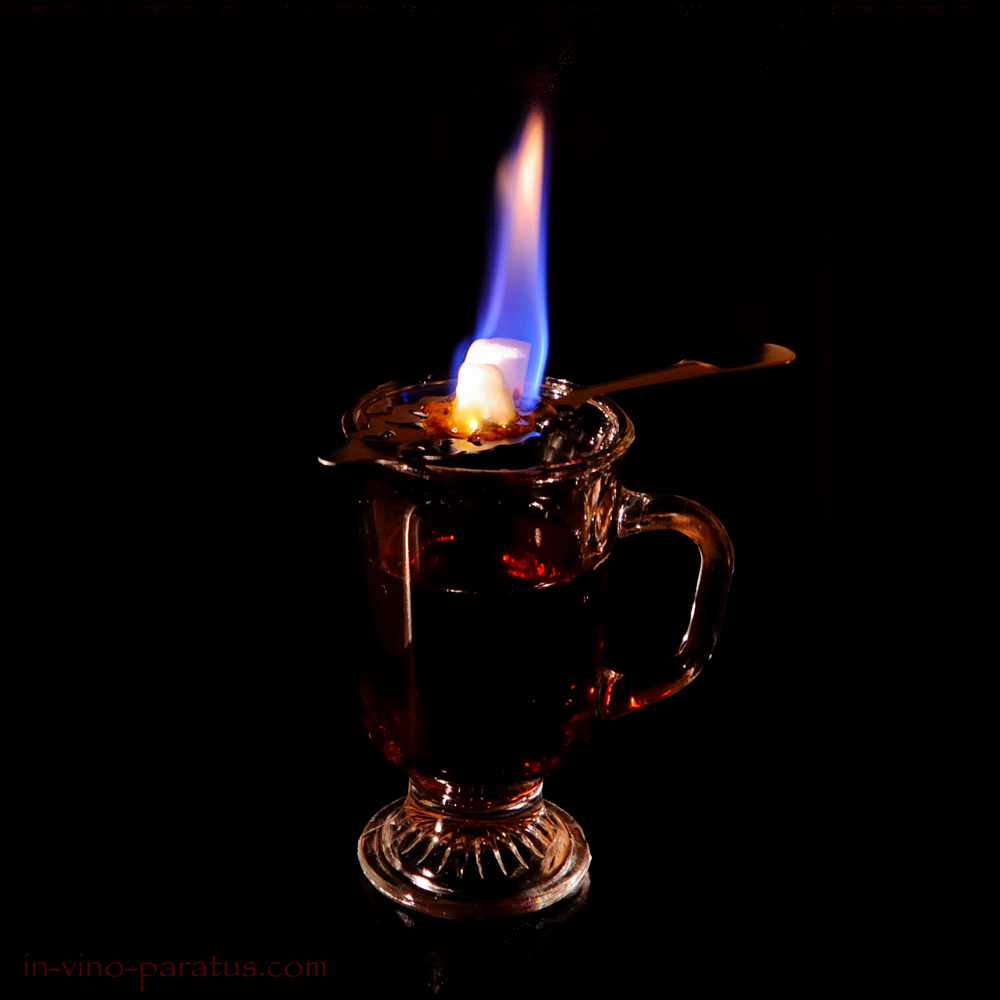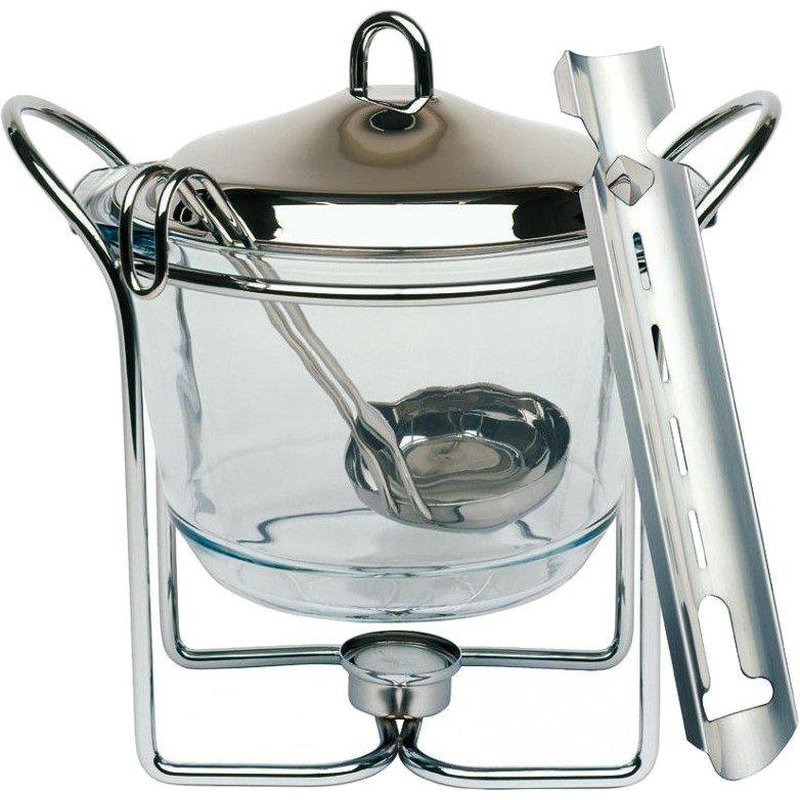
Winter is here, the holiday spirit is in the air, and it’s time for something not only warming but also cheerful.
Feuerzangenbowle is a traditional German drink based on Glühwein (hot mulled wine). Mulled wine has always been popular in Germany, especially during the winter months. However, it’s human nature to seek something new and exciting. This desire led to the creation of Feuerzangenbowle. The preparation is simple, but the result is spectacular—particularly the visual effect. First, make a pot of hot mulled wine. Then, place a sugar cone soaked in rum over the bowl of wine and set it on fire. As the rum burns, the sugar melts, caramelizes, and drips into the wine. Once the entire sugar cone has dissolved, the punch is ready to serve. The caramelized sugar imparts a distinct flavor to the punch, but the real magic of Feuerzangenbowle is in the fiery display. Traditionally, fire-tongs were used to suspend the sugar cone over the wine, which is why “Feuerzangenbowle” literally translates to “fire-tongs punch.”
Feuerzangenbowle has a long history. It became especially popular among German students in the mid-18th century. Try saying the name of the drink aloud—it’s tricky, isn’t it? Now imagine being a very drunk student and trying again. Almost impossible, right? It was for them, too. But when the soul craves more of this beloved drink, silence is hard to maintain. To solve this problem, the students gave Feuerzangenbowle a nickname: Krambambouli.
In truth, they borrowed the name. “Krambambouli” originally referred to a cherry liqueur produced by the Zum Lachs distillery in Danzig (now Gdańsk). This distillery was founded by Dutch Mennonite Ambrosius Vermöllen in the late 16th century and remained popular until it closed in the early 20th century. The name Krambambouli is much easier—and more fun—to pronounce than Feuerzangenbowle, so students began using it to describe their favorite flaming mulled wine. Actually, they called by this name every red and strong drink, including Feuerzangenbowle.
They even composed a song about it! In 1745, Christoph Friedrich Wedekind penned the now-famous Krambambouli song, which quickly became a favorite among the student community.
You can listen to it here. The page features both the German lyrics and an English translation.
By the way, German students aren’t the only ones with a penchant for kleptomania. The name Krambambouli was also “borrowed” by Belarusians, who added a slight twist to it—Krambambula. In Belarus, Krambambula refers to vodka flavored with honey and spices.
Now, back to the Germans and Feuerzangenbowle. Thanks to the enthusiasm of German students, the words Feuerzangenbowle and Krambambouli became synonymous for many people by the mid-19th century, though the official name has always remained Feuerzangenbowle.
Typically, people enjoy Feuerzangenbowle around Christmas, and it’s a popular offering at many Christmas markets throughout Germany. Its revival in popularity came in 1944, with the release of the film Die Feuerzangenbowle, a cinematic adaptation of Heinrich Spoerl’s humorous novel of the same name. The opening scene of the story unfolds around a bowl of Feuerzangenbowle, setting the tone for the rest of the film. While there have been several adaptations, it is this 1944 version that has become a staple of German Christmas traditions. To this day, many Germans watch the film during the holiday season, often accompanied by a steaming cup of Feuerzangenbowle.
Let’s shift from history to preparation.

Feuerzangenbowle is typically a communal drink, made in a larger container than a simple mug. Special sets are available for preparing it, which often include a glass or metal bowl, a burner to keep the wine warm, a serving spoon, and sugar tongs. These sets look elegant, and you can certainly buy one if you wish—but they’re not essential. Any pot of suitable size and any burner will work just fine.
Sugar tongs are quite handy (and you can purchase them separately), but they can also be substituted with something you already have on hand. For a more traditional touch, even fire tongs will do the job.
If it’s just two people—or even if you’re alone—and a whole pot feels like too much, you can prepare the punch directly in your serving cup, just as I’m doing now. You’ll still need a small pot to make the mulled wine, of course. For this smaller setup, forks can serve as makeshift sugar tongs. Personally, I’ve used an absinthe spoon—it works perfectly and is very convenient.
First, we need to prepare the mulled wine. You can find the mulled wine recipe in this my article. To stay true to the German version, use orange, cinnamon, clove, star anise, and cardamom. Reduce the sugar compared to the usual recipe. Once the mulled wine is ready, set it over a burner to keep it warm.
Place the sugar tongs (or your chosen substitute) over the pot or glass.
Next, position the sugar cone on the tongs. You’ll need 45 to 75 grams of sugar per bottle of wine, depending on your taste preference.
Now, soak the sugar cone with rum. Important! The rum must be at least 54% ABV to ignite. I used rum with 75% ABV. There are many strong rums available on the market, so be sure to check the label. Use a spoon to drizzle the rum over the sugar, then light it. Don’t forget to dim the lights to fully enjoy the mesmerizing effect of the flaming sugar.
If the rum burns out before all the sugar melts, simply repeat the soaking and lighting process.
Once the sugar cone has completely melted into the wine, the punch is ready to serve.
Savor the moment, and enjoy your Feuerzangenbowle!
Visit my online store for a unique poster featuring this cocktail, along with many other beautiful cocktails and other wine-related subjects.
It’s the perfect way to add a touch of sophistication to your kitchen or bar. Click here to shop now!